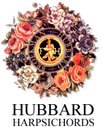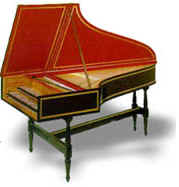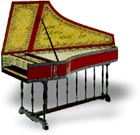If you have a question...
We want to answer it!
Send your questions about Hubbard Harpsichords or its products to
hubharp@aol.com.
Simpler yet, just click on the "Contact
Us" button in the upper right hand corner of any page to
send us a message.
Please direct comments or questions about the technical
aspects of the web site (things that are not clear, errors, and the like) to rshimko@twrite.com.
 Although
there are many harpsichord makers presently working in the United States, few, if any, are
without significant debt to Frank Hubbard (1920-1976), his research or his example. He
will be remembered as central to the revival of early music in the twentieth century.
Although
there are many harpsichord makers presently working in the United States, few, if any, are
without significant debt to Frank Hubbard (1920-1976), his research or his example. He
will be remembered as central to the revival of early music in the twentieth century.
For over 300 years the harpsichord was at the center of
countless sessions of music-making whether in the salon, palace, church or tavern. During
this time, few items could be encountered in daily life to exceed the harpsichord in
technological sophistication or value.
 Across Europe, master builders such as
Ruckers and Moermans in Antwerp, Blanchet and Taskin in Paris and Hass in Germany were
each to the harpsichord what Stradivarius, Amati and Guarneri became to the violin. The
designs and construction techniques developed in their workshops resulted in instruments
of such timeless beauty and magical sound as to influence the tastes of all composers of
the period. J.S. Bach, Handel, Scarlatti and Rameau are only the best known of a host of
composers who used the unique timber of the harpsichord to produce some of the most varied
and exciting keyboard music ever written.
Across Europe, master builders such as
Ruckers and Moermans in Antwerp, Blanchet and Taskin in Paris and Hass in Germany were
each to the harpsichord what Stradivarius, Amati and Guarneri became to the violin. The
designs and construction techniques developed in their workshops resulted in instruments
of such timeless beauty and magical sound as to influence the tastes of all composers of
the period. J.S. Bach, Handel, Scarlatti and Rameau are only the best known of a host of
composers who used the unique timber of the harpsichord to produce some of the most varied
and exciting keyboard music ever written.
Unfortunately, during the nineteenth century the art of
harpsichord making all but died out as the musical world turned its fancy to the piano. By
the early twentieth century it became almost impossible to find an artist/craftsman who
understood the old masters' secrets and could produce a harpsichord of equal standards.
 In 1948 Frank Hubbard
and William Dowd conceived the idea of constructing harpsichords which would restore to
their own time the sound and sensual beauty of the best classical instruments. Through
tireless research by compiling measurements of available antiques, and by examining
inventories of the old masters as recorded in local archives throughout Europe, the
ancient craft of harpsichord building was recovered and mastered. Now, as the popularity
of playing music on original instruments increases and the harpsichord takes center stage
with period orchestras, we recognize that theirs was an idea whose time had come.
In 1948 Frank Hubbard
and William Dowd conceived the idea of constructing harpsichords which would restore to
their own time the sound and sensual beauty of the best classical instruments. Through
tireless research by compiling measurements of available antiques, and by examining
inventories of the old masters as recorded in local archives throughout Europe, the
ancient craft of harpsichord building was recovered and mastered. Now, as the popularity
of playing music on original instruments increases and the harpsichord takes center stage
with period orchestras, we recognize that theirs was an idea whose time had come.
